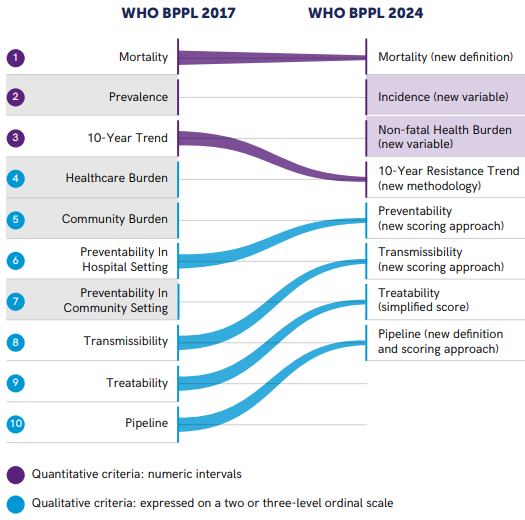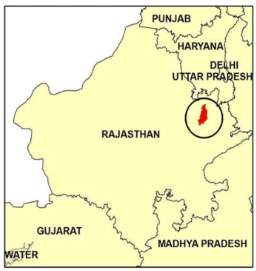Bacterial Pathogens Priority List (BPPL)
The Bacterial Pathogens Priority List was updated as critical priority pathogens continue to present major global threat.
- Developed by – World Health Organisation (WHO)
- Aim – To list bacterial pathogens of public health importance to guide research, development and strategies to prevent and control antimicrobial resistance.
Antimicrobial Resistance (AMR) occurs when bacteria, viruses, fungi and parasites no longer respond to medicines, making people sicker and increasing the risk of disease spread, illness and deaths. It is driven in large part by the misuse and overuse of antimicrobials.
- 2024 edition – Built on the 1st edition that was published in 2017.
- It updates & refines the prioritization of antibiotic-resistant bacterial pathogens to address antibiotic resistance.

- Categories – Critical, high, and medium priority groups.
- Coverage – 24 pathogens, spanning 15 families of antibiotic-resistant bacterial pathogens.
- Notable pathogens
- Gram-negative bacteria resistant to last-resort antibiotics
- Drug-resistant mycobacterium tuberculosis
- Other high-burden resistant pathogens – Salmonella, Shigella, Neisseria gonorrhoeae, Pseudomonas aeruginosa, and Staphylococcus aureus.
- Significance – Act as a guide for prioritizing R&D & investments in AMR, emphasizing the need for regionally tailored strategies.
- It also targets policy-makers responsible for developing and implementing AMR policies and programs.
References
- The Hindu| Critical priority pathogens pose a global threat
- WHO| Bacterial Priority Pathogens List 2024
Sariska Tiger Reserve
The Supreme Court has ordered to shutter 68 mines operating within a 1-km periphery of the critical tiger habitat (CTH) of the Sariska reserve.
Both the Wildlife Protection Act, 1972 and Environment Protection Act, 1986 prohibit quarrying in and around a tiger reserve.
- Located at – Alwar in Rajasthan, nestled in the lap of Aravalli hills.
- Ecosystem – It contains mountains, grasslands, dry deciduous forests and cliffs which span over 800 square kilometres.
- Biodiversity – Nearly 90% of the area in the sanctuary is covered with dhok trees accommodating various wildlife species.
- Currently home to numerous animals apart from tigers.
Sariska Tiger Reserve is home to India's largest population of peafowl, and harbours quail, sand grouse, golden- backed woodpeckers and crested serpent eagles, among other species.
- Also the Siliserh Lake on the edge of the park has a large number of crocodiles.

- Historical significance – It houses the ruins of medieval temples of Garh-Rajor that date back to the 10th and 11th centuries.
- Also a 17th century castle on a hilltop at Kankwari provides a panoramic view of flying vultures and eagles.
Sariska was declared as a sanctuary in 1955, attained the status of a National Park in 1979 and became a Sariska tiger reserve in 1978.
- Concerns – Illegal mining and soft boundaries (undefined).
References
- The Indian Express| Illegal Mining in Sariska Tiger Reserve
- Sariskanationalpark| Sariska Tiger Reserve
Scheme for Care and Support to Victims
There are many gaps in the Scheme for Care and Support to Victims.
- Legality – It is under Section 4 and 6 of the Protection of Children from Sexual Offences (POCSO) Act of 2012.
- It is a centrally funded scheme from NIRBHAYA fund of the Ministry of Women and Child Development.
- Objectives – To provide integrated support and assistance to minor pregnant girl child victims under one roof.
- To facilitate immediate, emergency and non-emergency access to a range of services for long term rehabilitation.
- Implemented through – The State/UT Governments.
- Eligibility – Any girl below the age of 18 years, who is a victim of
- Penetrative Sexual Assault - Section 4 of the POCSO Act
- Aggravated Penetrative Sexual Assault — Section 6 of the POCSO Act
- Section 376, 376A-E of Indian Penal Code, 1860 (IPC)
- And becomes pregnant due to such assault or rape is covered.
- Services offered
- Safe Transportation, Police Protection & Safe space to live
- Health Services, medical examination
- Counselling and Mental Health Services
- Health Insurance Coverage
- Education and Vocational Skills
- Legal Aid and Assistance
- Monetary and Other Entitlements
- Care under Mission Vatsalya – Monetary and care
- Challenges – It remains silent on whether the benefits will continue to be provided if the victim of a reported case opts for a medical termination of pregnancy (MTP) or has a miscarriage.
- Victims under the POCSO Act, including those who are pregnant, do not automatically qualify as Children in Need of Care and Protection (CNCP).
References
- The Hindu| Challenges in Minor girl victim support scheme
- Vikaspedia| Scheme for Care and Support to Victims
Shamlat deh
Supreme Court (SC) allowed a review of its 2022 judgment on ‘shamlat deh’ land rights.
- Shamlat deh – It is essentially village common land.
- Created by – Multiple landowners contributing an equal portion of their individual land holdings.
- Aim – To serve the “common purposes” of village’s people.
- It is not one patch of land but consists of several chunks and has been classified in many land areas.
- Gora Deh – The place in a village where cattle are gathered before going to the pasture.
- Abadi Deh – The chunks of land on which houses or mosques, temples or gurudwaras are constructed.
- Rights – Landholders in a village are entitled to get a share of the ‘Shamilat’ land as per the ratio of their holdings which means they have proprietary rights in Shamilat land in proportion to the size of their holdings.
- Karnail Singh vs State of Haryana, 2024 – It held that the 2022 decision vesting control of the land in the panchayat once the land is assigned was “totally contrary” to the Constitution Bench in Bhagat Ram case.
- It also directed the challenge to the 2003 High Court decision to be heard once again soon.
|
Ajit Singh v State of Punjab (1967)
|
- In land Acquisition, the beneficiary is state.
- In modification/ extinguishment of Land Rights, the beneficiary is not the sate unless the rights are transferred to the state after the rights of the land-holder are extinguished
|
|
Bhagat Ram vs State of Punjab (1967)
|
- It referred to Ajith Singh case (1967), said that reserving the land for income of panchayat is effectively acquiring the land.
- If the beneficiary of the scheme was the panchayat, then the state is also a beneficiary.
- The management and control does not vest in the Panchayat…till possession has changed and that land-holders would still have rights over their holdings.
|
|
2003 Judgement by Punjab & Haryana High Court
|
- The state and the gram panchayat could not acquire land that is not reserved under the consolidation scheme without providing compensation, as this violates the 2nd proviso of Article 31A.
|
Article 31A of the Indian Constitution deals with ‘Saving of laws providing for acquisition of estates, etc.’, which came into force through the 17th constitutional amendment of 1964.
2nd provision of 31A prevents the government from acquiring land from a person, if the size of the land is below the “ceiling limit” (which changes based on the state and the applicable law), unless the state pays compensation “not be less than the market value” for the land.
Reference
The Indian Express| Shamlat Deh Land judgement
Chir pine
During forest fires in Mussoorie and Landour, one of the pine cones would catch fire up above and come rolling down and start it all over again.
- Also, locally known as Chir ka ped.
- A Chir pine or or the longleaf Indian pine, is a conifer can grow up to a height of about 30 metres.
- Scientific name – Pinus roxburghii
- Distribution – Native to the Himalayas, and was not introduced to the Himalayas by the British, as is often believed.
- Found all over the Western Himalayas at an elevation between 1,000 and 2,000 metres, it covers about 16% of the forest area in Uttarakhand.
- Features – It can be identified by its 3 needles and its round cone (unlike the elongated cones of other pines).
- Growing conditions – It can be seen growing on steep slopes, grow even in sunlight exposed sites and the root system of pine is shallow and it doesn’t require a lot of water.
Chir pine is one of the 6 pines in India that have maximum occurrence and area.
- Area expansion – Historically, it was due to the expansion of Indian Railways and resin-tapping during the colonial times.
- Economic significance – Used for resin-tapping, locally known as lisa, is used for making turpentine oil after distillation.
- The wood is used by the people as a source of firewood and locally sourced timber for their houses and other wooden furniture needs.
- Concerns – It has inflammable leaves or needles.
- Forest Fires — The pine needles are highly inflammable and are the leading cause of forest fires in the region.
- Being fire-resistant, pine tree doesn’t burn in this fire and sheds leaves again next year, continuing this cycle every year.
- Biodiversity Loss — Due to the forest fires every year, a lot of animals and useful plant species which are not fire-resistant die leading to fauna and flora loss in the region.
- Degrade Lands — Because of the pine presence, bacteria’s in the soil die, and replaced by a parasitic fungal relationship.
- It only helps pine thrive and grow while taking away resources available for other plants.
- Lack of Water Retention — Because of the lack of bacteria, the water holding capacity of the soil decreases and the region with the pine trees is mostly drought-prone.
- No Use for Livestock — Pine needles are not used as a cattle feed, or bedding material for the livestock of the people, thus it is effectively of no use to the locals for their animal welfare.
References
- The Indian Express| Uttarakhand’s Chir pine role in forest fire
- AIF| Chir Pine

